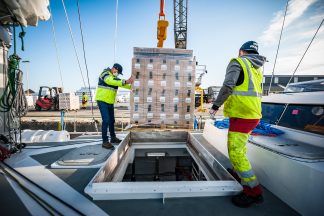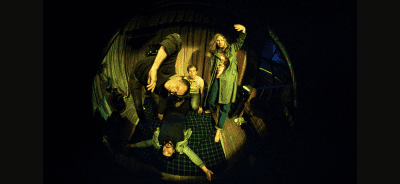On the high seas with 15,000 bottles of wine
Visiting the Grain de Sail schooner, fresh off a wind-powered trip from Brittany to Brooklyn
Stepping aboard Grain de Sail’s brand-new freight sailboat docked at the Brooklyn Navy Yard just before Christmas, I was met by an unshowered crew, their French accents thick as sediment. Empty wine bottles clattered about, but a faint smell of something stronger filled one’s nose. I don’t speak French, though the word “putain” punctured the air enough: Gallic seamen swear just as much as any other sailor.
Fresh off its 28-day maiden voyage across the Atlantic Ocean, this 72-foot schooner—powered only by wind—had arrived from France’s northwest region of Brittany on December 16 carrying very precious cargo: 15,000 bottles of wine.
Founded in 2010, Grain de Sail is pushing the boundaries of what green transit and a more sustainable logistics chain can look like in the 21st century. The company’s mission: To make and ship boutique products with the lowest possible carbon footprint.
Moored next to a fleet of New York City ferries, the schooner looked slightly misplaced. Grain de Sail’s Matthieu Riou, a 26-year-old with a cherubic face and piercing blue eyes, greeted me at the dock.
“One hundred years ago, all of cargo shipping was made with boats with sails,” he said. “We didn’t reinvent anything, we just tried to show that it is still possible to do it with cargo sailboats with safety, security and with all of the technology we have now too.”
Grain de Sail started as a coffee roasting company in 2013, added chocolate to its offerings three years later. The company, which employs around 40 people full time, only recently ventured into exporting organic French wine. Because Brittany is not traditionally a winemaking region, Grain de Sail doesn’t produce its own wine, but it does sail and sell bottles for nine winemakers from other parts of France. (The company does have a partnership with a vineyard in Burgundy that produces pinot noir and chardonnay, which are labeled “Gran de Sail Wines.”)
Its freight sailboat was custom-built so that the company could move its products—and the raw materials required to make them—in an environmentally responsible way. Wind turbines, hydro-generators and solar panels power all of the navigation tools onboard, as well as the air conditioning used to control the temperature of the wine.
After spending just 10 days in New York Harbor to unload wines from the various vineyards across France, the boat left for the Dominican Republic on December 28 to retrieve cocoa and coffee beans, before its return to Brittany.
Gonna need a bigger boat
The company has already begun building a larger vessel, which will be twice the size of its current ship. It’s expected to be ready in 2023 and will make transatlantic voyages, while the company’s current schooner will be relegated to trips between New York and the Dominican Republic.

Down the hatch!
Back inside the wheelhouse, I asked the crew if they ran into any trouble crossing the Atlantic. Captain Loïc Briand mentioned that the boat was engulfed by 50-foot waves, but the seasoned veteran called it a standard trip nonetheless.
“The whole goal of the project is that we want to keep our selling point as close to the factory as possible,” said Riou. For this reason, the chocolate and coffee is only sold in Brittany to minimize truck travel to other parts of France.
“For the wines,” he continued, “it’s complicated because you cannot [produce] French wines in New York, but this is why we are not selling any of the wines in other states. It makes no sense to use a cargo sailboat to deliver French wines to New York City, to then put them in a truck to go to California.”
As director of the company’s wine operations in America, Riou is tasked with selling all 15,000 bottles to restaurants, bars and shops across New York.
So far so good.
French sommelier Pascaline Lepeltier, formerly of Rouge Tomate, and award-winning wine writer Alice Feiring, have already tasted the wine. Several Brooklyn shops have also expressed interest in trying the wine. Owner Karin Holm Torres of Corkscrew in Clinton Hill says that if the wine passes her taste test, she would absolutely stock her store with Grain de Sail wines.
“I’m interested in it as a concept; it’s really cool what they’re doing,” she says. “I love that they’re bringing in some smaller producers, that they’re carbon friendly, and it’s a sexy boat.”
While sail freight is certainly an attractive and environmentally sustainable way of transporting goods for smaller companies, it’s not exactly scaleable, according to Cortney Worrall, president and CEO of the Waterfront Alliance, a New York-based nonprofit.
“There have been a number of attempts over the years that show that sail transport just doesn’t compete yet in a viable way with the modern, full-scale, massive port operations that we have in the East Coast and in New York Harbor in particular,” she says.
Among the bigger challenges, according to Riou, is the uncertainty that comes from relying solely or primarily on Mother Nature: A ship might be delayed because of weather or lack of wind. Larger companies need to know precisely when their cargo will arrive, and it’s imperative for big cargo ships to be punctual to get slots in the harbor.
Gran de Sail hopes to have a coffee roasting outpost and chocolate factory operating in Brooklyn in 10 years, according to Riou. The Navy Yard itself is an enticing possible local headquarters.
“Brooklyn seems really dynamic, and really wanting to improve what is possible to improve, and to be a game changer in industries and sectors,” he said. “It’s a good fit for us because with our project, we are trying to give some hope that you can manage an adventure even in this challenging time, and we feel the same spirit in Brooklyn.”
You might also like 


























